Affiliation:
1Institute of Continuous Media Mechanics UB RAS, 614013 Perm, Russia
2Perm State National Research University, 614068 Perm, Russia
Email: shadrin@icmm.ru
ORCID: https://orcid.org/0009-0004-8172-6168
Affiliation:
3E.A.Vagner Perm State Medical University, 614990 Perm, Russia
Email: splaksin@mail.ru
ORCID: https://orcid.org/0000-0001-8108-1655
Affiliation:
3E.A.Vagner Perm State Medical University, 614990 Perm, Russia
ORCID: https://orcid.org/0009-0006-0187-7818
Explor BioMat-X. 2025;2:101334 DOI: https://doi.org/10.37349/ebmx.2025.101334
Received: November 27, 2024 Accepted: March 31, 2025 Published: April 09, 2025
Academic Editor: Andreas Rosenkranz, University of Chile, Chile
The article belongs to the special issue The Use of 2D Materials in Bio-tribology
Aim: The purpose of this study is to investigate the deformability and strength of silicone breast implant shells from different manufactures as a function of implantation time.
Methods: The strength properties of about 200 shells of Eurosilicone, Mentor, Motiva, Allergan, Arion, PIP silicone breast implants removed for various reasons during repeated surgeries with a period of stay in the body from 6 months to 29 years were measured and compared with the corresponding properties of four shells of unused Eurosilicone and Motiva implants. Deformation was measured using a videoXtens extensometer.
Results: The mechanical properties of the Allergan implant shell are almost completely consistent with the properties of the Eurosilicone shell after 9 years of use. The Mentor implants showed greater strength and stiffness. The Motiva implant shells initially had higher ultimate properties—rupture stress and rupture strain—in comparison with the Eurosilicone implant shells.
Conclusions: The strength and deformation properties of all examined breast implant shells decrease in the course of time. After 13 years of use, the strength of breast implants is halved and their rupture strain is reduced by one third. The main mechanism responsible for loss of strength is the accumulation of microdamages during long-term use of breast implants. The thickness of the nano-textured shells of Motiva implants is twice less of the Eurosilicone implant shell thickness. This was possible due to a significant increase in the mechanical properties of Motiva shells.
Breast augmentation with implants is one of the most common aesthetic surgeries carried out on people who wish to increase breast size, to restore its shape, and to reconstruct breast after cancer surgery. According to official data for 2021, about 3.5 million women in the United States have breast implants [1]. However, since 2015, more and more people have chosen to remove their implants. Over the last five years, the number of such surgeries has increased by 46.3% [2]. Although silicone breast implant technology is continuously improving, the rupture rate of implants within 10 years after implantation ranges from 5.8% (Sientra implant) to 23.7% (Mentor implant), and after 10 years it is estimated to be 23.7% [3, 4]. Silicone breast implant ruptures can result in serious complications, such as granuloma formation, cellulitis, cutaneous ulcers, and migration of silicone to distant lymph nodes and organs [5–8]. The migration of silicone to regional and distant lymph nodes with their enlargement as a result of the formation of silicone granulomas is described relatively more often [9–12].
There are a lot of scientific papers focused on the changes in breast implants and on the variations in their mechanical and chemical properties [13–16]. Marotta et al. [17] studied the properties of shells and gel of 74 implants from different manufactures that were removed for various reasons in the period from 2 to 19 years after the first operation. Implant ruptures occurred in 42% of cases. Some of the shells were so thin that they could not get specimens to test the mechanical properties of the device. It was found that the shells contained mainly extractable liquid silicone and a very small amount of cross-linked silicone. The removed implants had a lower tensile and tear strength of the implant shells compared to unused implants, and even more so with the manufacturer’s declared parameters. Analysis of almost ten thousand defective implants showed that the probability of rupture of shells directly depends on the duration of their stay in the body and after 10 years reaches 47%, and after 18 years—69%. Nevertheless, a significant correlation between the implantation time and the change in the strength of the prosthesis shell could not be obtained due to the insufficient amount of data on the mechanical properties of the implants used. According to the authors, the primary decrease in the strength of the prosthesis shell is caused by the swelling of the shell elastomer due to the diffusion of silicone oil from the gel. Eventually, there are more reasons for shell failure, including breast implant movement, cyclic stresses that concentrate in the most thinned areas, defects and bends as a result of folding implant capsules.
Kononetz et al. [18] studied the changes in the properties of shells and gels in 35 implants (13 unused implants and 22 implants removed after 1 to 20-year insertion) from 8 manufacturers by measuring the moduli of elasticity or viscosity and the properties of breast implant shells, which include tensile strength, relative elongation and tear resistance. The obtained results were compared with those obtained after 7 to 10-year use of the implant shell. There was a decrease in the strength and elasticity of the shells of all prostheses, but not more than 10%. Anatomical implants showed higher stability and a high modulus of elasticity. Changes in the viscosity or elasticity of the filler occurred in all cases, but varied mainly due to brands.
Breast implants are not static devices and can age and even degrade over time. Their production is strictly regulated by requirements that include mechanical and physical-mechanical tests, evaluation of the silicone gel filler, strength, integrity of the shell and the influence of the environment on the condition of the implant. This highlights the need for continuous monitoring and evaluation of surgical outcomes to ensure patient safety and satisfaction [16]. Most authors support the need for the removal of ruptured implants [19–21]. In case of extracapsular rupture, it is also necessary to remove all the tissues soaked in silicone gel and reconstruct the breast [1, 22].
The aim of this work is to study the deformability and strength of different types of implant shells depending on implant duration.
In the period from 2004 to 2024, 201 patients were operated on for such complications as implant rupture, seromas or grades III and IV capsular contractions with an implantation period from 6 months to 19 years. The ruptured breast implants were completely removed or replaced with breast implants from 12 manufacturers. A total of 394 implants were investigated.
Different types of implant shells were studied: Eurosilicone, Mentor, Motiva, Allergan, Arion, PIP. Tensile strength analysis was carried out to investigate the strength properties of about 200 implant capsules extracted during repeated surgeries for implant ruptures or for other reasons, as well as for comparison of intact, unused implants.
The experiments were carried out on a Zwick/Roell’s four-vector test stand, where a videoXtens extensometer was used to measure deformation by tracing markers placed on the working part of the specimen. The specimens, which were cut according to ISO 527-2-5B standard cut unit, had a width of 2 mm and a working length of 10 mm (stretching rate 500%/min). In the experiments, three specimens from each implant shell were tested.
In order to plot general strength graphs for implant shells at different times of their stay in the body, the minimum tensile strength values were used. Although the stress-strain curves are the same, within the margin of error, for the same type of breast implant shells (Figure 1), their rupture behavior differs greatly, which is attributed to the fact that the shell thickness varies slightly in different areas. Just these minimum values are the areas of interest for researchers and users because the implant breaks exactly at the points where the shell is weak and thin. In addition, microdefects are known to accumulate during the whole life cycle of breast implants [3, 23]. Besides, microdefects are unevenly distributed throughout the examined area, and the accumulation of defects proceeds faster exactly in a thinner cross-section of the shell.
It was found that, within the margin of error, the stress-strain curves are similar for breast shells of the same type and with the same implantation time (Figure 1), but they have large differences in their rupture behavior. This is due to the fact that the thickness of a breast shell varies to a certain extent in different regions of the shell. The most complete information on the strength of implant shells as a function of time was collected for Eurosilicone implants (Figure 2), and the less amount of data were obtained for the Mentor (Figure 3) and Motiva (Figure 4) implants, which were used for a short time. Several tests were conducted on the Allergan (Figure 5), Arion (Figure 6), and PIP (Figure 7) implant shells. Since the shells were subjected only to individual tests, the graphs for these shells are compared with the curves plotted for the Eurosilicone implant shell with the same breast implant life cycle.
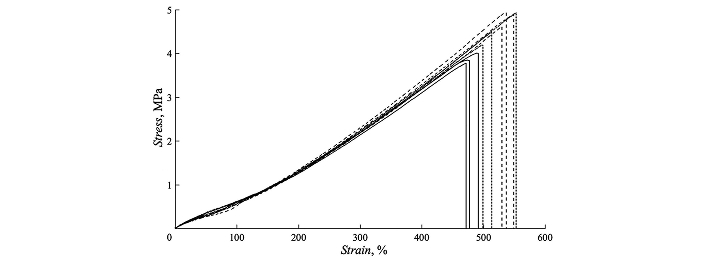
Stress-strain curves for the Eurosilicone implant shell after 8 years of use. The graph shows the stress-strain curves of three different shells with three samples each
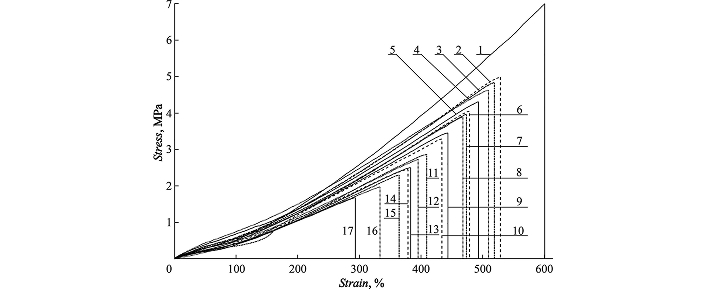
Stress-strain curves for the Eurosilicone implant shell at different times of implant stay in vivo. 1—control, unused implant; 2—6 years; 3—6.5 years; 4—7 years; 5—8 years; 6—9 years; 7—9.5 years; 8—10 years; 9—11 years; 10—12 years; 11—13 years; 12—14 years; 13—15 years; 14—15.5 years; 15—16 years; 16—17 years; 17—19 years
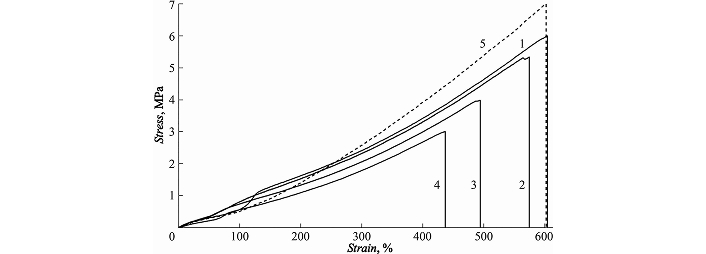
Stress-strain curves for the Mentor implant shell at different times of implant stay in vivo. 1—1 year; 2—3 years; 3—8 years; 4—11 years; 5—control Eurosilicone implant shell
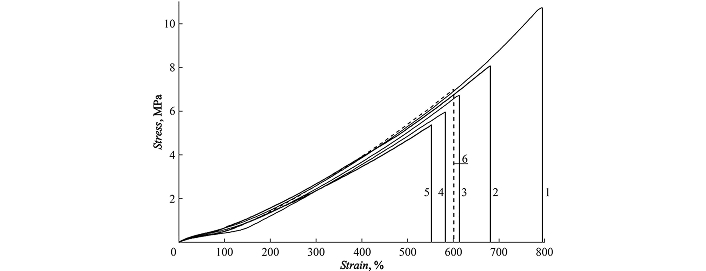
Stress-strain curves for the Motiva implant shell at different times of implant stay in vivo. 1—control, unused implant; 2—6 months; 3—1 year; 4—1.5 years; 5—2 years; 6—Eurosilicone control, unused implant
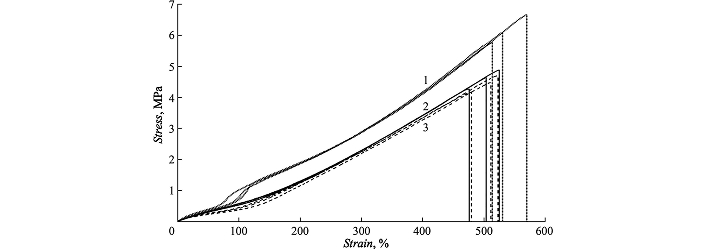
Stress-strain curves for the Allergan implant shell in comparison with other implants. 1—Mentor (9 years); 2—Allergan (9 years); 3—Eurosilicone (9 years). Three independent tests are given here for each material
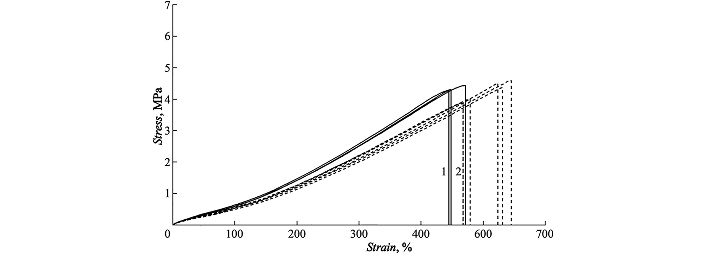
Stress-strain curves for the shells of the Arion (10 years) and Eurosilicone (10 years) implants. 1—Arion (three tests); 2—Eurosilicone (five tests)
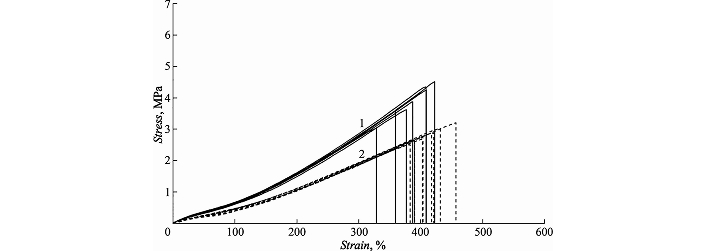
Stress-strain curves for the shells of the PIP (15 years) and Eurosilicone (15 years) implants. 1—PIP; 2—Eurosilicone. Shown here for each material are graphs of seven independent tests that were tested with multiple PIP and Eurosilicone shells at different times
As shown in Figure 5, the Allergan shell (0.75–0.93 mm thick) is almost identical in mechanical properties to the Eurosilicone shell after 9 years of use. The Mentor implants exhibit greater strength and stiffness.
In all experiments, the strength of the breast implant material was studied as a rupture strain, where the force is applied to the cross-sectional area. Thus, the greater the shell thickness, the higher the tensile strength. The thickness of the material practically has no effect on rupture deformation. Initially, the Motiva implant shells have greater ultimate properties (rupture stress and rupture strain) than the Eurosilicone implant shells. The manufactures have reduced the Motiva shell thickness (0.37–0.71 mm) compared to the Eurosilicone shell thickness (0.75–1.2 mm). The same is true for the PIP shells, the thickness of which ranges from 0.67 to 0.84 mm. Thus, the use of more wear-resistant Motiva and PIP shells allows their thickness to be reduced without weakening their performance properties.
The 0.81–0.97 mm thick Arion implant (Figure 6) after 10 years of use appears to be slightly more rigid and withstands a higher breaking force than the Eurosilicone implant, but the Arion implant has less risk of rupturing.
The stress-strain graphs of the PIP implant shell tests after 15 years of use demonstrate significantly higher strength and stiffness than those of the Eurosilicone implants. However, the rupture strains of these implants are much smaller.
Finally, a series of tests were conducted on the shell of the Eurosilicone implant, which stayed in the body only for 6 days and was removed for medical reasons (Figure 8). In contrast to the control, the unused specimen made of this material, the obtained results demonstrated a weakening in the mechanical properties of this shell. Most likely, this can be attributed to the accumulation of microdamage in the implants, which were deformed during the surgical procedure for inserting and positioning breast implants and their subsequent removal.
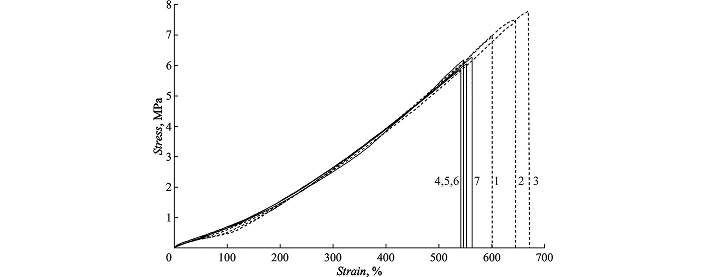
Stress-strain curves for the Eurosilicone shells. 1, 2, 3—control Eurosilicone implant; 4, 5, 6, 7—Eurosilicone after 6 days of use
Over 60 years of history of silicone breast implants, prosthetic shell technologies have been continuously improved to increase the safety and durability of breast implants [24]. Medical silicone, also known as polymethylsiloxane, consists of silicon, oxygen, hydrogen, and carbon. There have been five generations of silicone breast implants. A silicone gel-filled breast implant consists of a cross-linked elastomeric silicone shell containing a lightly cross-linked silicone gel [13]. Nowadays, the manufacturing standards for breast implants are outlined by the International Organization for Standardization (ISO). In contrast to previous generations, the fifth-generation implants are filled with a more cohesive gel that does not spread outside the capsule [1]. Probable causes of a reduction in the tensile strength of the implant shell and its rupture include damage from surgical instruments, implicit violation of the integrity of the implant shell, wear along implant folds, silicone protrusion, implant rupture caused by chest compression, and seat belt injury [1, 19]. Indirect evidence for the importance of cyclic movements in reducing the strength properties of the breast shell is the fact that ipsilateral implant ruptures are more prevalent in the dominant upper limb side [25]. The incidence of rupture is dependent on implant generation, age, manufacturer, and rupture diagnostic capabilities [26–28]. In our previous paper [23], we investigated a decrease in the strength of the breast implant shell with increasing time in vivo and described a microdefect accumulation mechanism associated with a systematic deformation of breast shells in the range of 90–150%. In testing the strength of the Eurosilicone breast implant shells with the period of life from 6 to 19 years, the loss of strength and rupture deformation in all shells was observed as a function of implantation duration. Moreover, at a short-term breast implant placement for only 6 days, the shell noticeably lost its strength compared to the control specimen, while its stiffness remains unchanged. This can be attributed to the fact that, the implant inserted through a small incision is subjected to considerable pressure. The placement and removal of breast implants are accompanied by damage accumulation. This suggests that the main mechanism for the loss of strength during the long-term use of implants is the accumulation of microdamages [23].
After a 10-year follow-up period, the probability of rupture for the implants filled with a highly cohesive and highly polymerized gel ranges from 4.7% to 5.8% [3, 4, 29]. The highest rupture rate was observed for PIP implants with a non-medical silicone with lower strength and high content of cyclic siloxanes known as D4, D5, D6. Moreover, the control and explanted implants of this manufacturer were characterized by significant differences in shell thickness in different areas of the implant, exceeding the manufacturer’s specification. Stress was directly related to shell thickness. Differences in the thickness of the shells from other manufacturers met manufacture’s standards [26]. In our study, test specimens were taken from different areas of the implant shell. Note that the shell thickness was not the same everywhere, it varied within ± 0.2 mm or less. The obtained results confirmed that PIP implants demonstrated a higher rupture rate compared with other implants.
The stability of a breast implant shape, the properties of a gel filler and the thickness of a shell vary between manufacturers, which affect the shape of the implant and the aesthetic result of the surgery [30]. The 21-year follow-up data confirmed that Mentor Contour Profile Gel implants are safe and effective and are able to ensure high level of patient satisfaction [31]. The comparison of smooth, macro-textured, micro-textured and nano-textured implants indicated that the latter two have the lowest risk of complications and the best strength properties [32–34]. In order to increase the strength of breast implants, they should be constructed of shells with increased thickness, but mechanical and physical properties will decay in this case. The manufacturers of breast implants have taken a different route to create a more durable material for silicone shells. For instance, Motiva breast implant shells are thinned to half the thickness of Eurosilicone implant shells. Therefore, such shells become more pliable and cause less discomfort. The expected lifespan of these prostheses remains approximately the same as for other types of breast implants.
The strength and deformation properties of almost all types of breast implant shells decrease with implantation time. Expecting long-term use, patients should bear in mind that, after 13 years, the strength of the shell is reduced by half and the deformability by one third.
Modern breast implants can be used for years if there are no medical, social or aesthetic indications for their removal. In individual cases, Eurosilicone implants were in the body for 19 years, and PIP implants for 15 years; they were removed for medical reasons.
The thickness of the nano-textured shells of Motiva implants is two times less than that of the Eurosilicon implant shells. This is due to a significant decrease in the mechanical properties of Motiva shells. In comparison with Eurosilicon implants, the smaller thickness of Motiva implant shells does not affect the strength of breast implants. The smaller thickness of the breast implant brings more comfort to the user.
VVS: Investigation (experimental tests), Writing—original draft. SAP: Investigation (Conducting surgical operations), Writing—review & editing. VAP: Investigation (experimental tests and the investigations).
The authors declare that they have no conflicts of interest.
Not applicable.
Not applicable.
Not applicable.
The data supporting the findings of this study cannot be shared publicly due to a confidentiality agreement. However, questions regarding the methods, analysis, or materials described in the manuscript may be directed to the corresponding author, who will facilitate scientific discussion within the scope of the research presented.
The work was performed within the framework of the state order of the Ministry of Science and Higher Education of the Russian Federation (subject no. AAAA-A20-120022590044-7). The funders had no role in study design, data collection and analysis, decision to publish, or preparation of the manuscript.
© The Author(s) 2025.
Open Exploration maintains a neutral stance on jurisdictional claims in published institutional affiliations and maps. All opinions expressed in this article are the personal views of the author(s) and do not represent the stance of the editorial team or the publisher.
Copyright: © The Author(s) 2025. This is an Open Access article licensed under a Creative Commons Attribution 4.0 International License (https://creativecommons.org/licenses/by/4.0/), which permits unrestricted use, sharing, adaptation, distribution and reproduction in any medium or format, for any purpose, even commercially, as long as you give appropriate credit to the original author(s) and the source, provide a link to the Creative Commons license, and indicate if changes were made.
